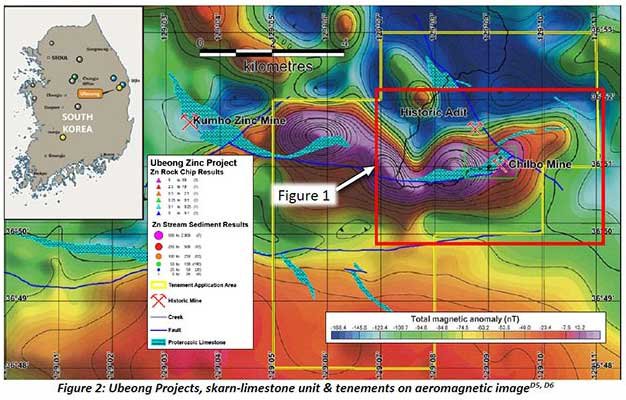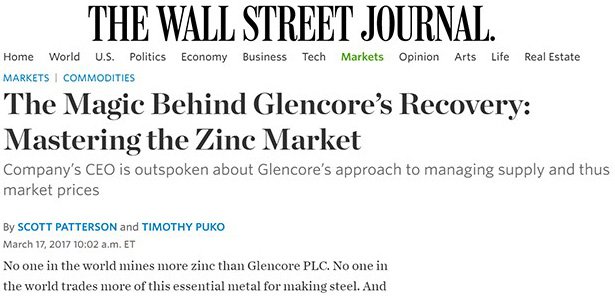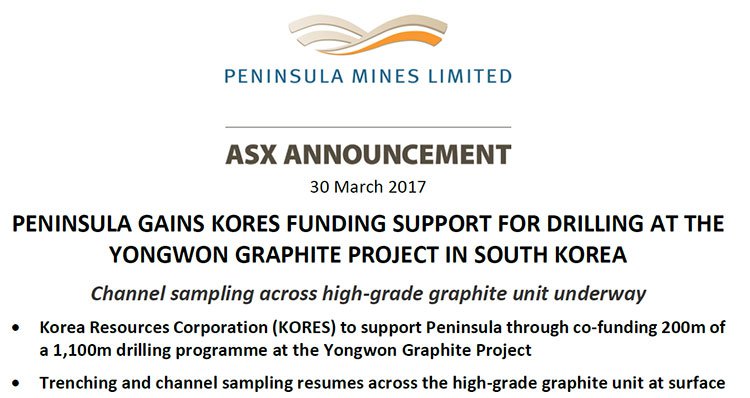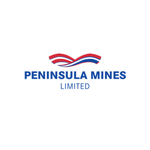ASX Stock Hones in on Graphite and Lithium to Supply Advanced Asian Battery Market
Published 17-OCT-2016 10:11 A.M.
|
14 minute read
Hey! Looks like you have stumbled on the section of our website where we have archived articles from our old business model.
In 2019 the original founding team returned to run Next Investors, we changed our business model to only write about stocks we carefully research and are invested in for the long term.
The below articles were written under our previous business model. We have kept these articles online here for your reference.
Our new mission is to build a high performing ASX micro cap investment portfolio and share our research, analysis and investment strategy with our readers.
Click Here to View Latest Articles
South Korea is the world’s largest lithium ion battery manufacturer, home to high tech companies such as Samsung, Hyundai and LG.
However, the country has very little in the way of local graphite or lithium resources to supply battery manufacturers...
One ASX explorer, capped at less than $9 million, is focussed on changing this situation in South Korea, with a large and growing portfolio of graphite and lithium projects – two essential ingredients in lithium ion batteries.
South Korea is not often in the news in terms of mining projects, but it’s a country that has historically generated robust gold production, as well as being highly prospective but under explored for in vogue materials such as lithium and graphite.
This company is focused on the hottest commodities, lithium, graphite and also gold-silver and zinc-silver – in South Korea.
Given South Korea is a leading manufacturer and major end user of graphite and lithium, it means this little ASX stock has a well-developed market to sell whatever it can find.
One only has to examine mining companies that have operations in Africa and South America to realise the importance of being able to establish offtake agreements with manufacturers, as well as having ready access to end markets.
Offtake deals are key goals for this ASX company, and given it’s spent quite a few years already in the country, the company is well placed to seize these opportunities.
That’s not to say this early stage company will gain an offtake agreement anytime soon, so if looking at this stock for your portfolio seek professional financial advice.
It is important to note here that this company has already found high-grade graphite at surface at three key project areas, with large flake identified in two of those areas and has delivered highly anomalous lithium results indicating a new pegmatite trend.
Meanwhile gold drilling is imminent and a new discovery of high grade zinc-silver in workings on new tenements has been made.
With all this in mind, proximity becomes even more important for another reason beyond potential offtake agreements. Proximity to markets is also critical in driving down transport costs, allowing producers to be more competitive compared with peers that have operations thousands of kilometres from manufacturing hubs in the Asian region.
While South Korea is a powerhouse manufacturer in its own right, it is also on the doorstep of major manufacturing centres in China and Japan. Importantly for this company, South Korea has top-class infrastructure and logistics to support big business, including everything from mining to manufacturing.
With market leading technology companies such as LG, Samsung and LS-Nikko leading the way in the tech sector, it is obvious that major corporates like doing business in South Korea.
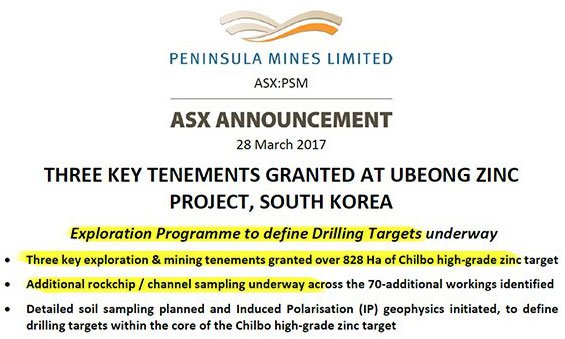
Which is exactly why today’s ASX stock is exploring for minerals in the region.
By targeting lithium and graphite prospects in South Korea, this company is hoping to exploit this country as the market leader in lithium-ion battery technology and other high-tech products where those commodities have applications.
It would appear that the company may well be in the right place at the right time.
Introducing...
At the start of October Peninsula Mines Limited (ASX:PSM) raised $1.68 million from current shareholders and new investors at an issue price of 2.1 cents. These funds will be used to immediately accelerate exploration initiatives right across the group’s portfolio of projects.
Importantly, the placement price was broadly in line with PSM’s trading price at that time, indicating a strong level of investor confidence in the company’s prospects.
In fact its share price has been up 300% related to its project acquisition and positive newsflow in 2016:
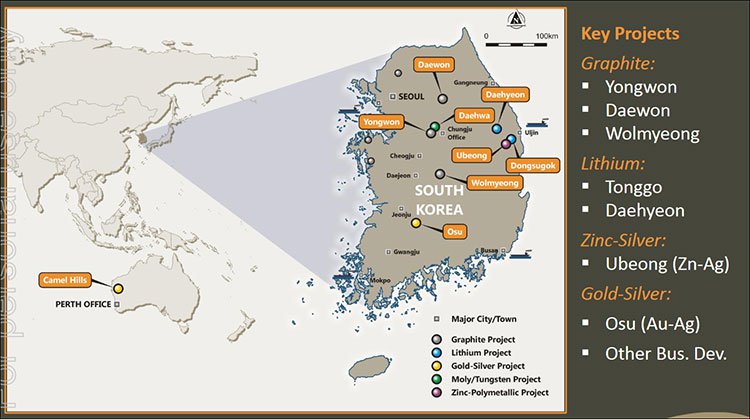
The past performance of this product is not and should not be taken as an indication of future performance. Caution should be exercised in assessing past performance. This product, like all other financial products, is subject to market forces and unpredictable events that may adversely affect future performance.
PSM’s strategy is to focus on mineral commodities which have a positive price outlook and potential off-take in-country – which makes a lot of sense.
The company has already established, and is growing, a portfolio of graphite, lithium and gold-polymetallic projects in South Korea that all offer significant discovery potential.
South Korea seeking investment in mining industry
While South Korea has a rich history in terms of being an active mining region, the focus has turned to manufacturing over recent decades.
Yet geologically, the region remains highly prospective for multiple commodities including graphite and precious metals in the older pre-Cambrian craton, and gold-silver-base metals and pegmatite hosted lithium deposits in the Jurassic Cretaceous volcanic arc that forms the southern half of the country.
This happens to be where a number of PSM’s gold, lithium, and zinc silver assets are located. The volcanic arc is an older version of the arcs now centred on Japan-Philippines-PNG, part of the historically productive ‘rim of fire’ and host to some of the world’s largest mines.
So, given its prospectivity and local demand, South Korea has once again opened its doors to mining and recent headlines indicate why:
That’s just gold, what about lithium?
So it’s looking good for PSM being a mineral explorer in South Korea...
The fact that the South Korean government is now looking to stimulate mining activity promises to work in PSM’s favour as it actively supports projects, and in some cases provides funding.
In September 2015 PSM was awarded funding by the South Korean government to conduct a two hole/800 metre diamond drill program targeting down dip extensions relating to established mineralisation at Pal Gong East.
The exploration and mining policies in South Korea require tenement applicants to demonstrate identified mineralisation or move-on, effectively a ‘use it or lose it’ tenements policy, leading to opportunities becoming available. PSM is very active and established in South Korea so this provides the company with opportunities in terms of targeting prospective areas for exploration and development.
South Korea also offers a favourable tax regime with the government cognisant of the fact that supplies of minerals such as lithium and graphite are central to the country’s success as a prominent technology and manufacturing nation. The country has a skilled labour market to draw on and a strong work ethic is demonstrated by domestic employees.
However, despite South Korea being a developed and stable country, as is the case when doing business in any foreign jurisdiction there can be unpredictable developments and investors should consider PSM as a speculative investment proposition, particularly given the early stage nature of its projects.
Importantly, PSM has established a strong bond between it and the South Korean government, having been involved in projects in that country over the last five years. This is a significant benefit given the strong emphasis placed on credibility and trustworthiness in the broader Asian business community.
The fact that PSM has an executive team with 90 years of combined experience in the areas of exploration, geological expertise and corporate financing, and a track record of discovery – the CEO was directly involved with the brownfields discovery of over 1 million ounces of gold at Stawell in Victoria, will assist the company in maintaining the strong relationships it has built, as well as negotiating important issues around processes such as approvals, offtake agreements and funding.
Projects in progress
With an aggressive exploration strategy planned for the next six months across PSM’s graphite, lithium, base metals and gold assets, there are numerous potential share price catalysts, and upcoming activity will be prioritised on the basis of what is most likely to provide the best result for shareholders.
Graphite
As an overview, the most advanced projects in PSM’s portfolio are its graphite projects, in particular Wolmyeong, Daewon and Yongwon located in the centre of South Korea.
These feature very high in situ total graphitic carbon (TGC) grades that have been produced from surface outcrops and in the case of Wolmyeong from sampling historical underground adits.
PSM is currently finalising the results of petrography and initial metallurgical testing with the focus being the generation of a flake graphite concentrate that is suitable for the production of spherical graphite for lithium ion battery and anode applications and/or expandable graphite, or even the production of graphene.
Petrography results released towards the end of September demonstrated “jumbo” and very large graphite flakes in samples from the Yongwon and Daewon graphite projects, indicating potential for generating a premium large flake concentrate product for lithium ion battery applications.
Further high-grade surface rock chip sampling results returned impressive values including up to 76% total graphitic carbon (TGC) for Wolmyeong, 24.8% TGC for Daewon and 18% TGC for Yongwon.
This news triggered a share price spike of nearly 10%, but a lack of exploration data in the last month combined with broader market volatility has resulted in the company’s shares retracing since then, perhaps presenting a buying opportunity...
The past performance of this product is not and should not be taken as an indication of future performance. Caution should be exercised in assessing past performance. This product, like all other financial products, is subject to market forces and unpredictable events that may adversely affect future performance.
Initial metallurgical test work on the three aforementioned projects which will include grade optimisation of flake graphite concentrates, as well as systematic channel sampling of its broader graphite assets is expected to be conducted in the fourth quarter of 2016.
Below is a look at what is going on with the graphite flotation at the Daewon Project:

The recommencement of exploration news in itself could pique the interest of investors, or at the very least assist in shaping management’s ongoing exploration strategy and project prioritisation.
Gold
Given that the high grade gold silver target at Osu, situated in the south-west of the country, is now primed for drilling it could be argued that the level of confidence surrounding results from exploration at that deposit will be higher than early stage work in relation to some of PSM’s other assets.
Should this be the case, drilling at Osu could potentially have a more pronounced impact on PSM’s forward prospects, and in turn its share price.
The project includes historical workings extending from Baegun Mine to the Pal Gong East workings along a strike corridor of 1.5 kilometres, within which exists multiple high-grade gold-silver-polymetallic veins and shear zones flanking the northern and southern sides of Mt Pal Gong.
A 2008 airborne magnetic survey identified a significant magnetic high centred below Mt Pal Gong, potentially representing an underlying porphyry intrusion, possibly related to the high grade mineralisation.
The gold-silver-polymetallic veins at Osu were discovered in the 1930s and were exploited intermittently until the early 1970s. Assay results from a surface sampling program undertaken by PSM in 2014 confirmed the high grade polymetallic nature of mineralisation.
This included samples from historical dumps with gold grades of up to 18 grams per tonne, as well as silver grades up to 579 grams per tonne and copper up to 1.4%. Lead and zinc mineralisation was also identified.
PSM currently has one tenement at the site (Osu 23) over the historic workings, and it has applications over three adjoining tenements as can be seen on the diagram below.
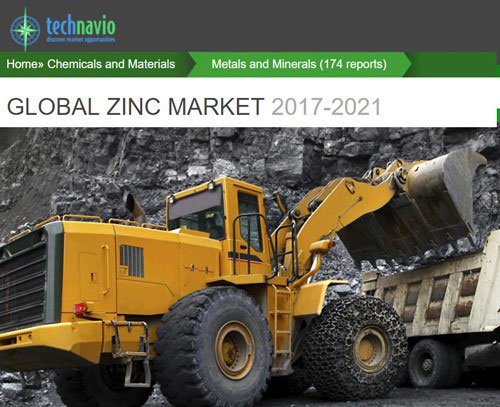
Lithium
In February PSM substantially expanded its portfolio of lithium projects in South Korea after successfully filing 53 tenement applications over an area considered highly prospective for pegmatite associated lithium mineralisation.
Management noted at the time that a review of historic countrywide Korea Institute of Geoscience and Mineral Resources (KIGAM) stream sediment sampling data highlighted an area to the south of the Sangdong tungsten mine where an aerially extensive lithium anomaly was centred had the highest concentration of lithium anomalies reported from the countrywide geochemical survey.
Subsequent stream sediment survey at the Dongsugok project produced very high results of up to 219 ppm lithium from the Tonggo prospect, up to 3 times the level attained from drainages at the Boam Lithium Mine, 3 kilometres to the east.
Also, the Daehyeon project produced high lithium stream sediment results of up to 124 ppm lithium which appeared to be associated with a north-south corridor of large pegmatites, the subject of follow-up rock chip sampling currently underway.
Further data from the Tonggo lithium anomaly can be expected in coming months as the results are spatially interpreted to enable PSM to undertake follow-up mapping, petrographic examination and further surface geochemical sampling.
Management is also considering geophysical exploration techniques in order to assist in the location of larger underlying pegmatite bodies.
Zinc-silver at Ubeong
In the course of stream sampling at Dongsugok, highly anomalous zinc results were identified, including 1465 ppm zinc and 813 ppm zinc in one drainage and up to 839 ppm zinc in another adjacent area closer to Mount Ubeong.
PSM subsequently traced smelter slag upstream to locate the two areas of substantial workings that have been sampled. A dump sample from an historic adit produced a result of 12.7% zinc, 19.1% lead and 669 grams per tonne silver. Furthermore, rocks chip sampling produced results including 5.4% zinc and 200 grams per tonne silver.
Providing management with added confidence that this may be a broader highly prospective zone, was a sample taken 430 metres to the south, which produced a result of 14.9% zinc.
An historic zinc mine is also located in the region where there is evidence of smelting activity and large historic mine dumps. Samples taken from this site also delivered high zinc grades as well as indications of rich copper mineralisation.
Over the next three months, PSM will be conducting follow-up testing across a 10 kilometre skarn horizon which will involve stream, soil and rock chip sampling.
The fire in the belly
One thing PSM won’t be light on is news flow with so many irons in the fire and with a market cap of less than $9 million, its current position provides strong upside to exploration success.
However, like all early stage exploration, there is no way of guaranteeing upcoming exploration results and investment decisions should not be made on the basis of forward-looking statements alone. Seek professional financial advice if considering this stock for your portfolio.
PSM has money in the bank, a team with a track record of discovery, a supportive government with a favourable operating and fiscal regime providing clear paths to market, and excellent infrastructure at its beck and call.
Meanwhile it is exploring in a region that has proximity to some of the biggest companies in the world with interests in lithium and graphite downstream applications. Think Samsung and LG to name just two...
There is no doubt these names and PSM’s proximity to them have the company buoyant about its prospects.
And with an aggressive field program in place to advance its key projects to drilling stage, it is well on its way to turning its diversification into a powerful asset.
General Information Only
This material has been prepared by StocksDigital. StocksDigital is an authorised representative (CAR 000433913) of 62 Consulting Pty Limited (ABN 88 664 809 303) (AFSL 548573).
This material is general advice only and is not an offer for the purchase or sale of any financial product or service. The material is not intended to provide you with personal financial or tax advice and does not take into account your personal objectives, financial situation or needs. Although we believe that the material is correct, no warranty of accuracy, reliability or completeness is given, except for liability under statute which cannot be excluded. Please note that past performance may not be indicative of future performance and that no guarantee of performance, the return of capital or a particular rate of return is given by 62C, StocksDigital, any of their related body corporates or any other person. To the maximum extent possible, 62C, StocksDigital, their related body corporates or any other person do not accept any liability for any statement in this material.
Conflicts of Interest Notice
S3 and its associated entities may hold investments in companies featured in its articles, including through being paid in the securities of the companies we provide commentary on. We disclose the securities held in relation to a particular company that we provide commentary on. Refer to our Disclosure Policy for information on our self-imposed trading blackouts, hold conditions and de-risking (sell conditions) which seek to mitigate against any potential conflicts of interest.
Publication Notice and Disclaimer
The information contained in this article is current as at the publication date. At the time of publishing, the information contained in this article is based on sources which are available in the public domain that we consider to be reliable, and our own analysis of those sources. The views of the author may not reflect the views of the AFSL holder. Any decision by you to purchase securities in the companies featured in this article should be done so after you have sought your own independent professional advice regarding this information and made your own inquiries as to the validity of any information in this article.
Any forward-looking statements contained in this article are not guarantees or predictions of future performance, and involve known and unknown risks, uncertainties and other factors, many of which are beyond our control, and which may cause actual results or performance of companies featured to differ materially from those expressed in the statements contained in this article. S3 cannot and does not give any assurance that the results or performance expressed or implied by any forward-looking statements contained in this article will actually occur and readers are cautioned not to put undue reliance on forward-looking statements.
This article may include references to our past investing performance. Past performance is not a reliable indicator of our future investing performance.


